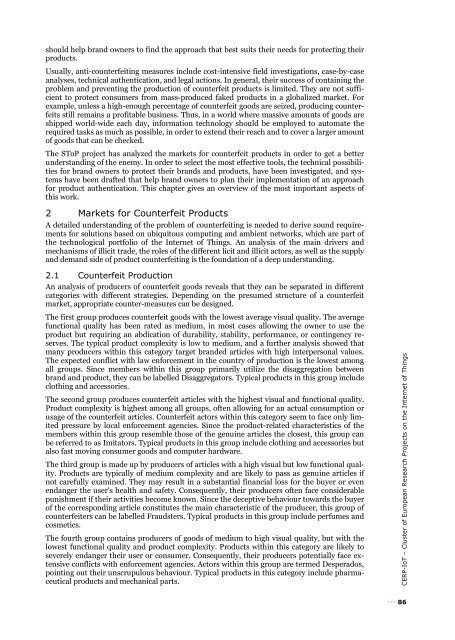Vision and Challenges for Realising the Internet of Things
Vision and Challenges for Realising the Internet of Things
Vision and Challenges for Realising the Internet of Things
Create successful ePaper yourself
Turn your PDF publications into a flip-book with our unique Google optimized e-Paper software.
should help br<strong>and</strong> owners to find <strong>the</strong> approach that best suits <strong>the</strong>ir needs <strong>for</strong> protecting <strong>the</strong>ir<br />
products.<br />
Usually, anti-counterfeiting measures include cost-intensive field investigations, case-by-case<br />
analyses, technical au<strong>the</strong>ntication, <strong>and</strong> legal actions. In general, <strong>the</strong>ir success <strong>of</strong> containing <strong>the</strong><br />
problem <strong>and</strong> preventing <strong>the</strong> production <strong>of</strong> counterfeit products is limited. They are not sufficient<br />
to protect consumers from mass-produced faked products in a globalized market. For<br />
example, unless a high-enough percentage <strong>of</strong> counterfeit goods are seized, producing counterfeits<br />
still remains a pr<strong>of</strong>itable business. Thus, in a world where massive amounts <strong>of</strong> goods are<br />
shipped world-wide each day, in<strong>for</strong>mation technology should be employed to automate <strong>the</strong><br />
required tasks as much as possible, in order to extend <strong>the</strong>ir reach <strong>and</strong> to cover a larger amount<br />
<strong>of</strong> goods that can be checked.<br />
The SToP project has analyzed <strong>the</strong> markets <strong>for</strong> counterfeit products in order to get a better<br />
underst<strong>and</strong>ing <strong>of</strong> <strong>the</strong> enemy. In order to select <strong>the</strong> most effective tools, <strong>the</strong> technical possibilities<br />
<strong>for</strong> br<strong>and</strong> owners to protect <strong>the</strong>ir br<strong>and</strong>s <strong>and</strong> products, have been investigated, <strong>and</strong> systems<br />
have been drafted that help br<strong>and</strong> owners to plan <strong>the</strong>ir implementation <strong>of</strong> an approach<br />
<strong>for</strong> product au<strong>the</strong>ntication. This chapter gives an overview <strong>of</strong> <strong>the</strong> most important aspects <strong>of</strong><br />
this work.<br />
2 Markets <strong>for</strong> Counterfeit Products<br />
A detailed underst<strong>and</strong>ing <strong>of</strong> <strong>the</strong> problem <strong>of</strong> counterfeiting is needed to derive sound requirements<br />
<strong>for</strong> solutions based on ubiquitous computing <strong>and</strong> ambient networks, which are part <strong>of</strong><br />
<strong>the</strong> technological portfolio <strong>of</strong> <strong>the</strong> <strong>Internet</strong> <strong>of</strong> <strong>Things</strong>. An analysis <strong>of</strong> <strong>the</strong> main drivers <strong>and</strong><br />
mechanisms <strong>of</strong> illicit trade, <strong>the</strong> roles <strong>of</strong> <strong>the</strong> different licit <strong>and</strong> illicit actors, as well as <strong>the</strong> supply<br />
<strong>and</strong> dem<strong>and</strong> side <strong>of</strong> product counterfeiting is <strong>the</strong> foundation <strong>of</strong> a deep underst<strong>and</strong>ing.<br />
2.1 Counterfeit Production<br />
An analysis <strong>of</strong> producers <strong>of</strong> counterfeit goods reveals that <strong>the</strong>y can be separated in different<br />
categories with different strategies. Depending on <strong>the</strong> presumed structure <strong>of</strong> a counterfeit<br />
market, appropriate counter-measures can be designed.<br />
The first group produces counterfeit goods with <strong>the</strong> lowest average visual quality. The average<br />
functional quality has been rated as medium, in most cases allowing <strong>the</strong> owner to use <strong>the</strong><br />
product but requiring an abdication <strong>of</strong> durability, stability, per<strong>for</strong>mance, or contingency reserves.<br />
The typical product complexity is low to medium, <strong>and</strong> a fur<strong>the</strong>r analysis showed that<br />
many producers within this category target br<strong>and</strong>ed articles with high interpersonal values.<br />
The expected conflict with law en<strong>for</strong>cement in <strong>the</strong> country <strong>of</strong> production is <strong>the</strong> lowest among<br />
all groups. Since members within this group primarily utilize <strong>the</strong> disaggregation between<br />
br<strong>and</strong> <strong>and</strong> product, <strong>the</strong>y can be labelled Disaggregators. Typical products in this group include<br />
clothing <strong>and</strong> accessories.<br />
The second group produces counterfeit articles with <strong>the</strong> highest visual <strong>and</strong> functional quality.<br />
Product complexity is highest among all groups, <strong>of</strong>ten allowing <strong>for</strong> an actual consumption or<br />
usage <strong>of</strong> <strong>the</strong> counterfeit articles. Counterfeit actors within this category seem to face only limited<br />
pressure by local en<strong>for</strong>cement agencies. Since <strong>the</strong> product-related characteristics <strong>of</strong> <strong>the</strong><br />
members within this group resemble those <strong>of</strong> <strong>the</strong> genuine articles <strong>the</strong> closest, this group can<br />
be referred to as Imitators. Typical products in this group include clothing <strong>and</strong> accessories but<br />
also fast moving consumer goods <strong>and</strong> computer hardware.<br />
The third group is made up by producers <strong>of</strong> articles with a high visual but low functional quality.<br />
Products are typically <strong>of</strong> medium complexity <strong>and</strong> are likely to pass as genuine articles if<br />
not carefully examined. They may result in a substantial financial loss <strong>for</strong> <strong>the</strong> buyer or even<br />
endanger <strong>the</strong> user's health <strong>and</strong> safety. Consequently, <strong>the</strong>ir producers <strong>of</strong>ten face considerable<br />
punishment if <strong>the</strong>ir activities become known. Since <strong>the</strong> deceptive behaviour towards <strong>the</strong> buyer<br />
<strong>of</strong> <strong>the</strong> corresponding article constitutes <strong>the</strong> main characteristic <strong>of</strong> <strong>the</strong> producer, this group <strong>of</strong><br />
counterfeiters can be labelled Fraudsters. Typical products in this group include perfumes <strong>and</strong><br />
cosmetics.<br />
The fourth group contains producers <strong>of</strong> goods <strong>of</strong> medium to high visual quality, but with <strong>the</strong><br />
lowest functional quality <strong>and</strong> product complexity. Products within this category are likely to<br />
severely endanger <strong>the</strong>ir user or consumer. Consequently, <strong>the</strong>ir producers potentially face extensive<br />
conflicts with en<strong>for</strong>cement agencies. Actors within this group are termed Desperados,<br />
pointing out <strong>the</strong>ir unscrupulous behaviour. Typical products in this category include pharmaceutical<br />
products <strong>and</strong> mechanical parts.<br />
CERP-IoT – Cluster <strong>of</strong> European Research Projects on <strong>the</strong> <strong>Internet</strong> <strong>of</strong> <strong>Things</strong><br />
86
















